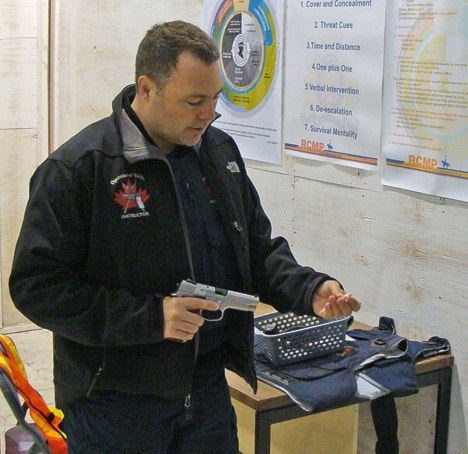The male voice on the other side of the door was the first sign of trouble.
I was delivering a subpoena to a woman who was supposed to appear in court after being assaulted by her husband.
He wasn’t supposed to be there.
This was the last in a series of scenarios framed around this same basic premise. Organized for the media at the RCMP’s Pacific Regional Training Centre in Chilliwack, the scenarios were intended to illustrate the type of situational training police undergo.
Each year more than 2,000 RCMP members from across British Columbia attend week-long courses at the PRTC.
Every day police encounter situations that could end badly. Ensuring they don’t is the product of training.
At their disposal is a fairly limited arsenal, ranging from their power of persuasion, to the semi-automatic at their side.
But perhaps the most important tool is one between their ears. In seconds they must assess the situation, categorize the risks, and determine the most effective response.
On paper, this is called the “Incident Management Intervention Model.”
There’s a nice drawing of how it’s supposed to work pasted on the wall in the “apartment” where we’re staging our scenarios. The challenge, says RCMP Cpl. Steve Hiscoe, a use-of-force instructor with the PRTC, is to understand the model and translate it into action quickly, and under difficult circumstances.
Scenario-based training is intended to help officers deal with the unexpected. It’s like a “stress inoculation,” Hiscoe says, that will hopefully inure them to the chaos of the moment, and help them make clear-headed choices when faced with real situations.
My hands are already shaking as I cinch up the belt that holds my retractable baton, my pepper spray, and a handgun that’s been loaded with f/x rounds. I’ve got an armoured vest on, and a helmet with a visor that makes me look and sound like Darth Vader.
Hiscoe sketches the scenario – to a point. My job is to react, then explain what I did and why.
The door opens and I sense trouble. The male tells me the woman isn’t home and identifies himself as her husband. He says they’ve worked things out. But there’s tension in his voice and aggression in his actions.
There’s a court order prohibiting the man from contact with his wife, so I tell him he’s under arrest.
His anger rises and things start to move fast. He moves toward me swearing, then backs away – a sign of submission?
He opens a kitchen drawer and I glimpse a gun. As I struggle to unholster mine, he yells he’ll count to five then “put me six feet under!”
I yell at him to put down his gun.
He cocks his weapon and continues to count.
At three I fire into his chest and he drops to the floor.
It’s over within seconds. My pulse races, my hands shake.
I hear Hiscoe’s voice behind me, prompting me to pick up the man’s weapon, otherwise I would have just stood there.
It was only an exercise, but my every nerve is on fire.
We sit down and Hiscoe asks me to explain what happened. It’s a critical part of the training experience, he says. It’s not enough to act, officers also need the ability to reconstruct what took place and clearly identify and articulate the motives behind the actions they took.
I was sent to serve a subpoena, he says, and now there’s a man dead or dying on a kitchen floor. Why?
That accountability has become even more important since high-profile cases like the death of Robert Dziekanski at the Vancouver Airport three years ago.
Since then, the court of public opinion has been as quick as it is has been damning, particularly if speculation is fueled by an absence of fact.
“We need to articulate our actions better than we have,” Hiscoe says.
If officers are going to go into dangerous situations they need the tools to explain their actions in a way that is honest and reflective of the multitude of circumstances they encountered and dealt with in a split second, he says.
The goal is to illuminate – not obfuscate the event – so lessons can be learned, lives can be saved, and incidents avoided.
Greg Knill is editor of The Chilliwack Progress
